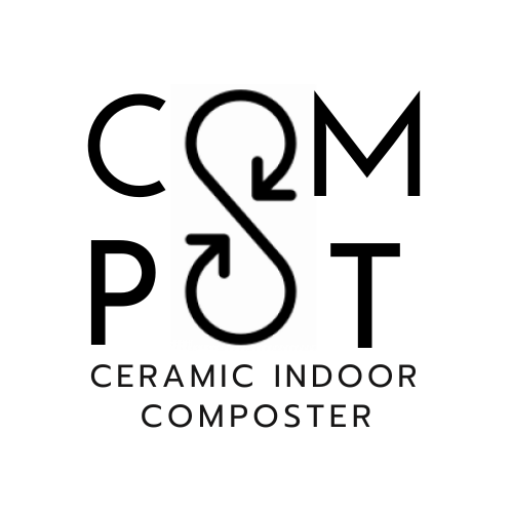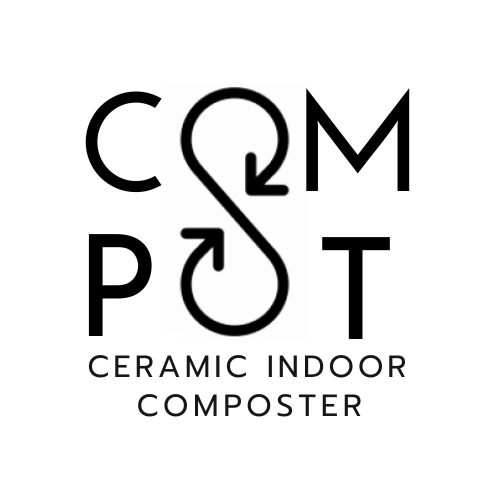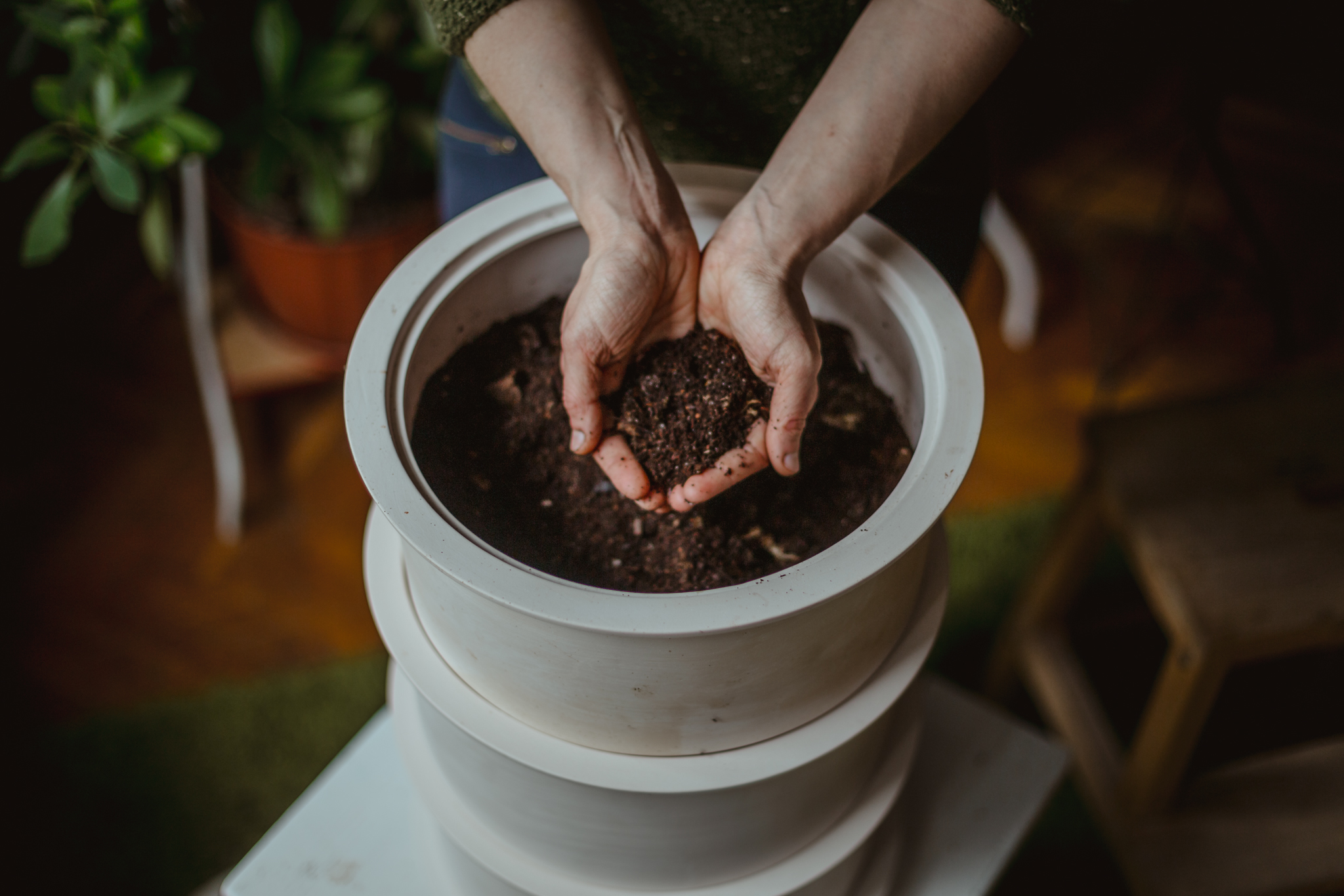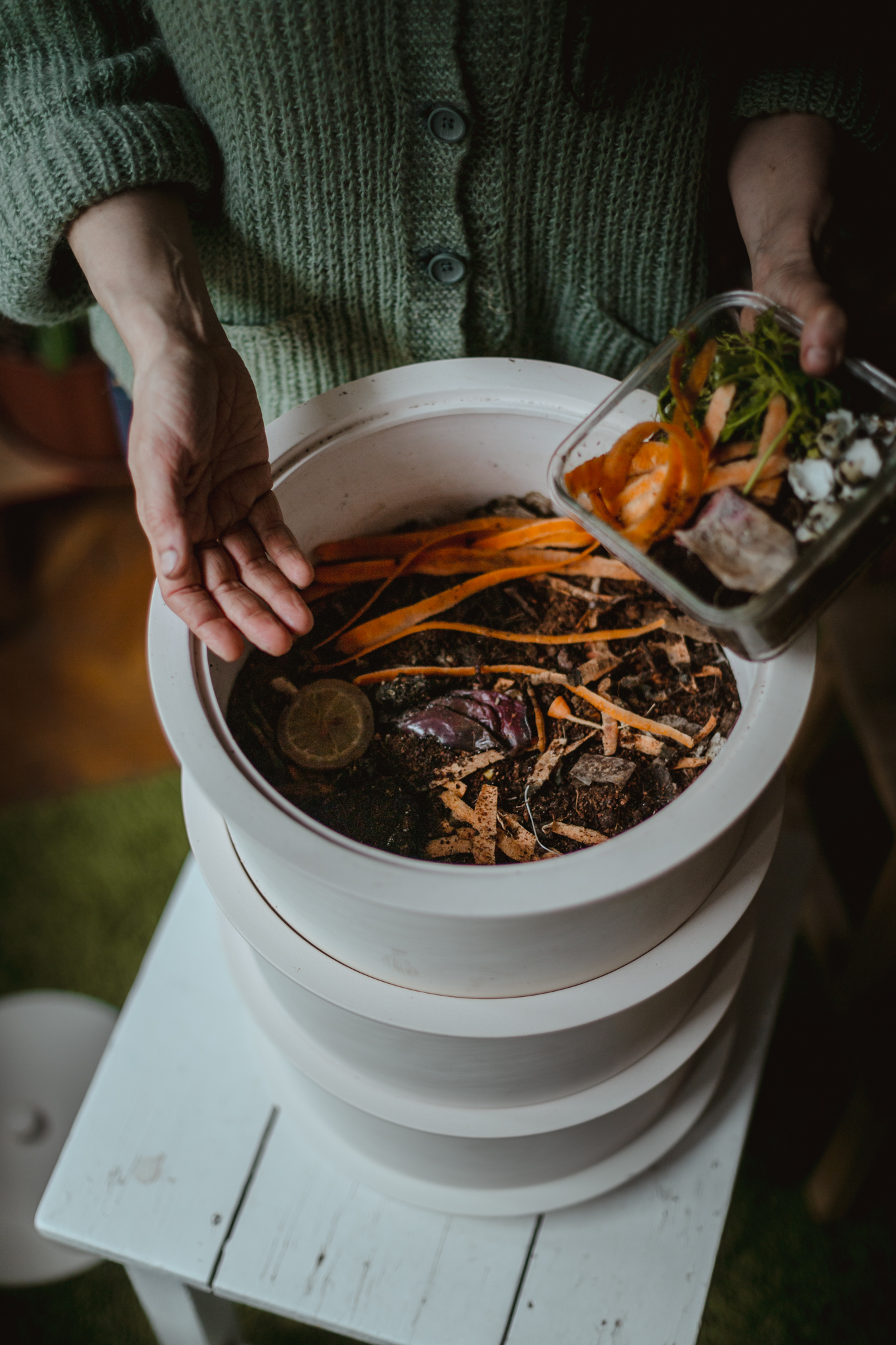Composting is one of the best habit change you could adopt in your household with the BIGGEST effect to reduce waste and be environmentally conscious. More and more of us are living in cities with no garden connection, and the city population will only just increase. As a result, we must rethink how we manage organic waste.
Composting matters because organic waste accounts for the majority (30-40%) of mixed municipal waste, which is transported to incinerators or landfills with the rest of the waste in garbage trucks.
Composting is a way to minimize the quantity of garbage we generate (about 350-400 kg per person per year) by and also make soil from your spoils and lower your eco-anxiety.
Why do mixed waste containers stink?🗑️
Most organic waste is not properly collected and is combined and treated with non-recyclable garbage. Unfortunately, the contents of the common mixed waste bin are simply not ‘going away’ and problem solved. Either it is incinerated or disposed of in a landfill.
Incinerator or landfill?
If your kitchen green waste ends up here, it will be removed from the natural cycle, most likely burned and released into the atmosphere as CO2, and the organic materials decomposing in the landfill will generate methan other potent greenhouse gas.
These are estimated to account for 6% of total global greenhouse gas emissions. In comparison, airplanes generate 1.9% of greenhouse gas emissions, while plastic production counts for 3.8%.
Lot of cities that focus on organic waste recycling claim and their biowaste bins are overflowing with plastic bags, glass, and other non-biowaste materials dumped in it. This means that if the organic waste collected is full of plastic bags, it cannot be processed correctly and, for example, converted into good quality compost.
Glass and other non-biowaste materials are being discarded. This means that if the organic waste collected is full of plastic bags, it cannot be processed correctly converted into any compost.
What is the connection between this and composting? How can the organic waste problem be addressed? ♻️
Composting, particularly local composting, is part of the solution. Composting solutions are currently available (community, garden, indoor – but local:). Most people simply require more information and care. Our local source of information is Humusz Waste Prevention Alliance – as a member of Zero Waste Europe Alliance. https://humusz.hu/biohulladek_allasfoglalas
What are the city composting options?
What can we do?
1️⃣Food Waste Prevention – According to the waste pyramid theory, “the best waste is waste that is not produced.” Prevention is the key. Pay close care to not creating more biodegradable waste.
2️⃣Organic waste is far more manageable when properly collected. Furthermore, because food waste does not contaminate other separately collected waste, it can be recycled more effectively.
3️⃣Compostingis another part of the the solution and to manage organic waste properly and naturally. There are many types of composting and more on this later. Instead of being burned in composting, the carbon in the compost is stably bound to the humus material, so it remains in the soil for a long time.
Much of the food waste is of vegetable origin, which can be treated by composting. There are also other biological processes that can be used to manage bio-waste, but local solutions are preferred here too.
So we need to take action to produce less organic waste and manage it properly, because every small step counts towards sustainability!
If you want to read more about composting and organic waste management
we recommend the Humus Association (https://humusz.hu/komposztalj)
And the Nébih No Waste educational programme https://maradeknelkul.hu/
🌱💚
oktatási program anyagait https://maradeknelkul.hu/
🌱💚
What actually is composting? 💚
Composting is an invention of nature: a cycle. Under the right conditions, organic materials (vegetable peel, fruit peel, tea leaves, etc.) are decomposed by decomposing organisms and simultaneously “built up” into humus in the finished compost. In a forest, think of transformation under the leaf litter. Composting is most similar to decay.
Organic waste is NOT trash. Finished compost, humus or “black gold” is actually a concentrated “vitamin cocktail” that helps your plants grow healthy and vigorous. Your plants will thank you for your nutrient-rich compost, and you couldn’t ask for a better way to make your soil fertile. What’s more, you’ll also reduce waste.
Making compost is humans’ way of imitating the natural process of decomposition and accelerated, making a super environment for decomposer organisms.
Composting is a controlled, aerobic (oxygen-required) process that converts organic materials into a nutrient-rich, biologically-stable soil amendment through natural decomposition. The end product is called ready compost or humus. Microorganisms feed on the materials added to the compost pile during the composting process. They use carbon and nitrogen to grow and reproduce, water to digest materials, and oxygen to breathe.
You can compost at home using compostable waste from your kitchen and dry material depending on the composting type that you choose (paper, dry leaves etc).
To understand, visualize – imagine a forest floor. Nature creates a yearly cycle of growth and decay and rebirth here: leaves fall in the autumn and mix with other dead vegetation and animal waste in a thick layer, gradually decomposing over the months. Full of locked up nutrients is broken down by insects, fungi and bacteria (the decomposers) that live in the soil and some part of it transforms and builds up into brown humus or ready compost. During this process the beneficiary nutrients are released and recycled for plants to use again.
We will write about what you can compost and what is not recommended in indoor composting in another blopost dedicatedfor this.
Urban composting methods
Methods of urban composting
We are many and varied and even in a heap in big cities or with large gardens. But believe me, there are many different ways of composting for city dwellers with many different lifestyles. Indoor and outdoor composting is a wonderfully diverse activity. Learn more about the composting methods, their pros and cons, so you can choose one that works successfully in your household.
If you have a garden, use garden composting methods.
If you have organic waste collection where you live, you can put it in an organic waste bin.But this option will not be available in all municipalities: it is expensive to build and run, and often the bins are inappropriately contaminated with plastic, making them difficult to recycle.

Community composting
The community can be (apartment building(s), a neighbourhoods, a municipality). In Budapest, where I live currently – composting sites are set up in partnership with the city park maintanance company in local parks or other sites and maintained by local residents on a voluntary basis. The finished compost is used collectively or according to their own needs of the people who use it, e.g. under flowerbeds, in balcony boxes. Under the local legislation, community composting is the composting of a community’s own vegetable waste on site and the use of the finished compost for its own purposes, which does not require a permit – this vary according to the cities and countries.
In the case of community composting, it is very important to appoint a responsible person, a “compost master:)”, who is skilled in composting and who supervises the operation of the community composter (you dont need to have a degree just be open for learning and following the composting). The process for community composting is the same as for garden composting. However, the choice of collection and ripening bins depends on the size of the condominium, the number of apartments/buildings and the size of the garden/yard. These and additional equipment can be purchased collectively by the community, saving money.

Sharewaste app
This is a biodegradable kitchen waste sharing app that connects people online who have extra kitchen waste and those who have extra space in their composting bin or have chickens, for example. After registering by email you can become a compost receiver or compost donor, it started in Australia and the map app is in use and working all over the world.
http://www.sharewaste.com
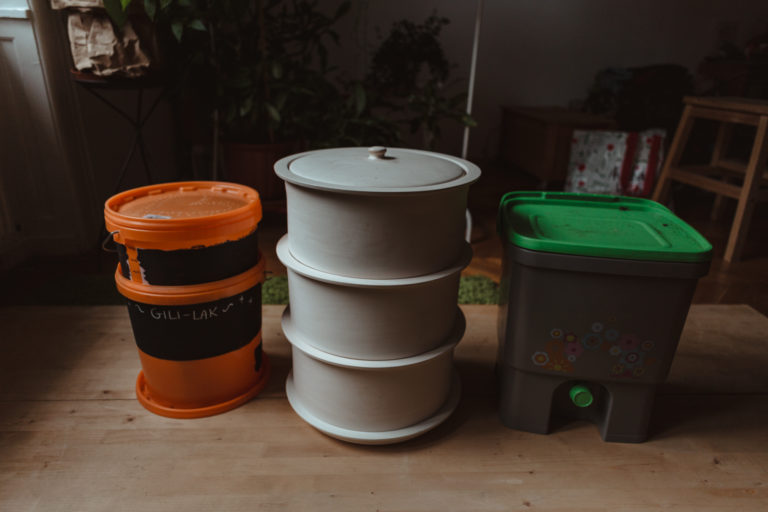
Indoor composting solutions:
And you can start with the most local solution for indoor composting. This option has super possibilities. It’s the most local way to get the most out of your organic waste. Indoor composting – which is COMPOT – can be done without a garden or community compost point and can be combined with other collection options if you happen to have too much biodegradable waste.
Wormcomposting (vermicomposting) –
Composting is done using worm castings in a DIY or purchased composter which can be made of wood or clay :). Composting worms are the red manure worms – Eisenia Fetida or other compost worms that can withstand indoor enclosed environments and can cope with kitchen waste several times their weight. There is no fear of worms climbing out, as they naturally stay where the nutrients are and their bodies are sensitive to UV radiation and dehydration. They will only come out of the box if the environment there is dangerous for them. Each time they are used, dry material (shredded office waste, shredded waste paper, dry leaves,
moistened coconut soil (from garden shops), used potting soil) should be added to the container to ensure that composting is done correctly. The advantage of this method is that the composting worms will accelerate the process under the right conditions and balance the composting bin. The disadvantage (and also advantage:) however, is the responsibility to create the right conditions for the new pets (they prefer an oxygenated environment between 10-28 C – no direct sunlight and no basement heat). In the upper part of the compost, close to the decomposing wastes, worms work freely and in the lower part nutrient-rich worm humus and liquid (worm compost tea) accumulates, which you can use to replenish nutrients for plants.
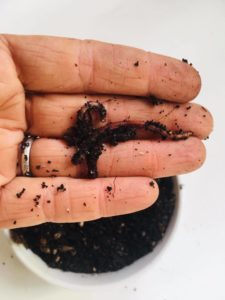
Anaerob elő-komposztálás (Bokashi eljárás) –
This is a readily available or DIY plastic container(s) in which a pre-composting process takes place using a fermented bran adjuvant inoculated with a specially developed aerobic (oxygen-free environment) microorganism. When used, the kitchen waste, cut into small pieces, and the composting aid are pressed together in the container as much as possible and thus filled to pre-ferment (eventually leaven) the kitchen waste and then buried in the open ground to complete the composting process.
It has the advantage that you can put your kitchen waste that has been strained with meat and dairy products in it, and it works not with worms but with a mixture of microorganisms. Disadvantage and good if you know that there is “smell” only formed inside the plastic bucket and it is a pre-composting process where it speeds up the decomposition process but it is not complete, it does not make compost so you need a garden/outdoor access to finish the process to bury the decomposing kitchen waste mixture pre-composted in the bucket in soil. The composting aid comes in plastic packaging and the process only works in plastic buckets.
A komposztáló segédanyag műanyag csomagolásban és a folyamat csakis műanyag vödörben működik.

Aerob indoor composting (COMPOT ceramic indoor composter)
-A plastic-free, breathable and aesthetic solution. It is made of clay, which is porous, so it breathes, cools and deodorizes to provide optimal conditions for composting. COMPOTs are made in Hungary in local ceramic workshops. The Indian Dailydump composters inspired us to make them and because India is so far away we started designing and researching how they work and in the end that’s how the current COMPOT was born.
COMPOT does not need worms, as it breaks down organic waste in the kitchen with the help of a natural preparation (activator) full of micro-organisms and because of the breathable nature of the clay. When used, feed the pot with a dry mix of your organic kitchen waste and bacteria culture (activator) once a week and after 4-6 months you will harvest mature forest-scented humus from your pot. COMPOT and the excipients come in biodegradable packaging, which you can compost in the pot, because we believe there is life without plastic.
It’s time to be more conscious about organic waste, because every little step counts on the road to sustainability! I hope I’ve got you in the mood to compost!
fenntarthatóság felé vezető úton! Remélem meghoztam a kedved a komposztáláshoz!🌱💚
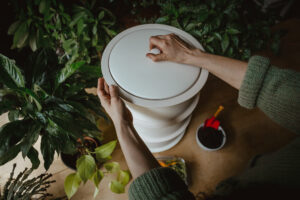
This is a testimonial interview here with a COMPOT composter Anna:) Check out the whole interview on our youtube channel https://www.youtube.com/watch?v=Ish_EUy1CbI Anna is a psychologist and used a worm composter before COMPOT, actually we set up together their composter with part of my compost worms:) She belives that all the tiny steps one does – e.g. in her households also – , reduces the anxiety concerning our global problems. She is finding CALMNESS, CONNECTEDNESS, JOY and CREATIVITY in her COMPOsT:)
Of course you think it’s good but you’ve never composted before and it seems complicated.
Don’t worry, COMPOT has an all-encompassing buyer’s guide that covers EVERYTHING from unpacking to composting and we also have open and free lectures and monthly webinars on composting.
And what can COMPOT compost and what can’t?
You can find it in our Insta stories, blog posts and FAQs on the website, or you can reach us on weekdays with your questions.
If you are interested in COMPOT you can find us here in our webshop
